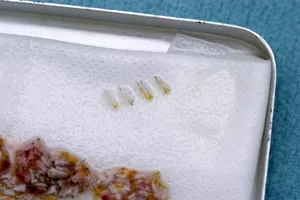Key points
Female hair loss is a prevalent condition with a particularly devastating psychological impact.
Hair transplantation is the only currently available option to provide a permanent and natural solution for female patients with alopecia.
Surgery for female patients should be performed in strategic areas to produce the maximum cosmetic impact.
Grafts containing 1 to 6 hairs can be used to create different zones of density.
Female patients need to understand the postoperative sequelae and the evolution
Treatment goals
Unique to female hair transplantation is the advantage that female pattern hair loss (FPHL) does not usually cause complete alopecia in any area, rather the affected regions become thinner.1 Therefore, it is reasonable to focus hair transplant surgery in the most cosmetically significant regions as opposed to the surgical treatment of men that requires a more diffuse coverage of the affected areas that are, or will become over time, totally alopecic (Fig. 1). The hair restoration surgeon (HRS)
The initial consultation
The first meeting with patients should begin with a thorough discussion of the family history of female hair loss and a pertinent medical history of the patients themselves. One of the most important medical issues to review in depth are hormonal disorders or recent changes, including some of the more common ones related to hair loss: polycystic ovarian syndrome, adding/stopping/changing birth control pills, perimenopause, menopause, postpartum hormone changes, thyroid abnormalities, and
Preoperative planning for female hair restoration
The most important aspect of preoperative planning in females is deciding the size and location of the area to be treated. The donor area should be carefully assessed to provide an estimate of the number of follicular units that can be harvested in one surgery as well as the total lifetime estimate of available donor hair. This assessment will help inform the surgeon’s decision regarding which area should be treated in the present surgery and which area or areas might be important to address in
Preparation for hair transplant surgery
Patients who are not having deeper anesthesia provided by an anesthesiologist are told to eat a good breakfast and take an antibiotic 1 hour before surgery.
On arrival at the office, patients read and sign the consents for surgery, photographs, and anesthesia. Then the area to be treated is again delineated with a grease pencil and the photographs with dry and wet hair are obtained.
Patients are administered diazepam and the combination preparation of hydrocodone bitartrate and acetaminophen
Anesthesia
In addition to the preoperative medication given to patients, an intravenous line is inserted to provide fluids throughout the day and provide ease of access for additional medications to be administered.
Just before beginning the local anesthesia, midazolam and fentanyl are injected. A regional block in both the donor and recipient areas is achieved by gradual infiltration of 2% lidocaine with 1:100 000 epinephrine
The recipient area block is completed after the donor area has been sutured; a
Immediate postprocedural care in hair transplantation
Patients are given detailed instructions for the postoperative period.14
In most cases, minoxidil is used in the recipient area after graft placement is completed; telfa (Kendall, Tyco Healthcare Group, Mansfield, MA) gauze with antibiotic ointment and a bandage are applied for overnight.
Unless there is a contraindication for patients, the following postoperative medications are dispensed: a tapering dose of prednisone, Vicodin, ketorolac, zolpidem tartrate (Ambien) and antinausea medications.
Recovery, potential complications, and their management in hair transplantation
The author tells every patient what to anticipate in the immediate postoperative period and when to expect certain key developments after surgery.
Special situations for hair transplant in women
Most of the female patients seen in the author’s practice have patterned hair loss. However, there are patients with cicatricial alopecia, trauma, and a significant number who have an altered hairline following facial plastic surgery (Fig. 7). The hairline is reconstructed using old photographs and the HRS’ own aesthetic sensibilities as a guide. Simultaneously, even fine scars, which may have resulted from the plastic surgery, can be transplanted and camouflaged successfully. All patients with
Conclusion
Women are becoming more open about the problem of FPHL and therefore there has been an increase in the number of women seeking a means of addressing this issue. Ideally, women should be advised regarding treatments which may slow future loss and informed as to the potential results they can expect from surgical hair restoration. Surgeries performed with meticulous care and a sound long-term surgical plan are extremely successful and make a significant impact in patients' lives.







Post comments